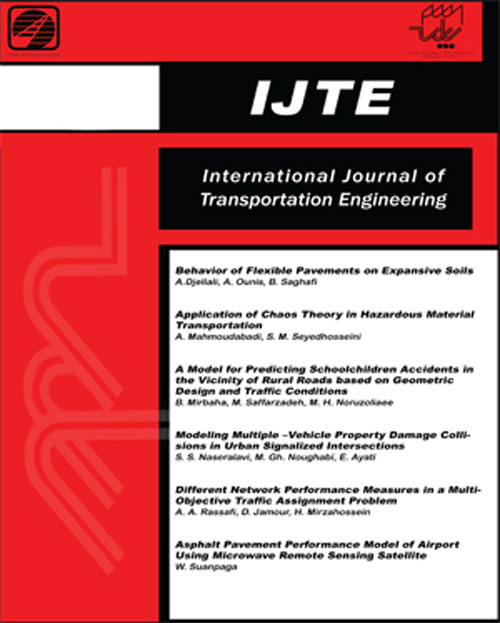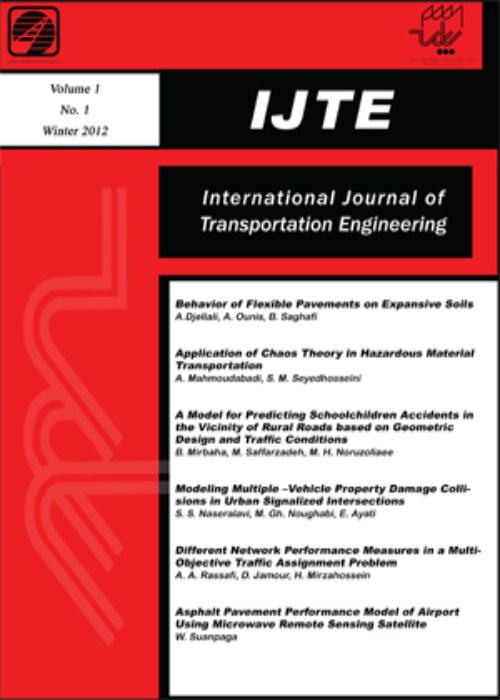فهرست مطالب

International Journal of Transportation Engineering
Volume:3 Issue: 1, Summer 2015
- تاریخ انتشار: 1394/08/28
- تعداد عناوین: 6
-
-
Pages 7-15Lateral resistance of railway track is one of the most important parameters in lateral stability. This parameter depends!on the conditions of different components of ballasted railway track (such as density of ballast layer, sleeper spacing, type of sleeper, etc.). From this perspective, type of sleeper has an important effect on lateral resistance. However in some conditions, in technical and economical investigations, using a special type of sleeper is not avoidable. In this research, concrete, wooden, and steel sleepers are studied using experimental and numerical analysis by finite element method. According to the experimental results, concrete sleeper B- 70 with 2.06 tons has the most lateral resistance among three types of sleepers. Steel and wooden sleepers with the amounts of 1.32 and 1.10 tons are in the next ranking. On the other hand,numerical analysis (modeled according to field conditions) shows that the lateral resistance of concrete, steel, and wooden sleepers is equal to 2.10, 1.36, and 1.15 tons, respectively.Keywords: Lateral resistance, ballasted railway track, concrete sleeper, wooden sleeper, steel sleepers
-
Pages 17-29Vehicle crashes are amongst the major causes of mortality and results in losses of lives and properties. A large number of the vehicle crashes occur on rural roads. Accidents become more noteworthy in two-lane roads due to going and coming traffic. Therefore, prediction of crashes and their causes are considerably important to reduce the number and severity of the accidents. The safety index is a suitable quantity for determination of road safety degree. It informs us to study the number of accidents in a specific road and time. In this study, safety index of two-lane rural roads is predicted by Artificial Neural Network (ANN), Radial Basis Function Neural Networks (RBFNN) and Adaptive Neuro-Fuzzy Inference System (ANFIS) algorithms using MATLAB software. The number of causes which ends to an accident is related to some parameters. We chose seven new parameters as inputs to the ANN, RBFNN and ANFIS methods that are geometric and statistical values of the roads and one output variable that is the safety index of segments of two-lane rural roads. 5 roads in Ilam Province, Iran, were selected for the case study to train, validate and test the proposed estimation models. Finally, the results show that, it is possible to predict the safety index of two-lane rural roads with a high correlation coefficient and a low mean square error (MSE) in relation to real values. The ANN method has a higher correlation coefficient and lower MSE in comparison to RBFNN and ANFIS methods. The achieved correlation coefficient and MSE for validation of the ANN approach are 0.94 and 0.0086 respectively, and correlation coefficient of 0.845 and MSE of 0.019 for all data.Keywords: Safety Index, crashes, artificial neural networks, two, lane rural roads
-
Pages 31-43In this study, an artificial neural network was developed in order to analyze flexible pavement structure and determine its critical responses under the influence of standard axle loading. In doing so, more than 10000 four-layered flexible pavement sections composed of asphalt concrete layer, base layer, subbase layer, and subgrade soil were analyzed under the impact of standard axle loading. Pavement sections were analyzed by means of multilayered elastic analysis theory and critical responses of pavement including maximum horizontal principal tensile strain at the bottom of asphalt layer and maximum vertical compressive strain on the top of subgrade were computed in each case. Then, a Feed-Forward back propagation neural network was served to predict these responses. The results show that the artificial neural network can be used as a powerful and accurate tool to predict the critical response of flexible pavements. Application of artificial neural networks for pavement analysis reduces the analysis time and can be used as a quick tool for predicting fatigue and rutting lives of different pavement sections and so in optimum design of pavement structure.Keywords: Pavement analysis, Artificial Neural Network, critical responses, standard axle
-
Pages 45-54The Highway Safety Manual [HSM, 2010] recommends safety evaluations be performed before implementing any roadway treatment to predict the expected safety consequences. Safety consequences can be measured using crash prediction models, Crash Modification Factor (CMFs), or both. This paper develops a CMF to show the expected impact of red-light cameras (RLCs) on safety at signalized intersections. A CMF is a multiplicative factor used to compute the expected number of crashes after implementing a given countermeasure at a specific roadway site. RLCs are intended to improve drivers alertness to avoid causing accidents. This paper analyzes accident data reported at thirteen signalized intersections in Virginia Beach in 2008 before the RLCs were installed and 2010 after the RLCs were installed. Safety performance functions (SPFs) and the empirical Bayes (EB) before-after methodologies are used to develop a CMF for this countermeasure. The result shows an overall CMF of 0.8 , which is a 15.4% safety improvement. This result is not absolute; however, but sets a starting point for further investigations and potential inclusion in the future editions of the HSM.Keywords: Safety, crash modification factors, red, light cameras, signalized intersections, empirical Bayes
-
Pages 55-66In this study, different contents of Nano-silica, 2 wt.%, 4 wt.% and 6 wt.%, have been added to bitumen to modify the physical, mechanical and rheological properties of warm mix asphalt (WMA). WMA is containing 2 wt.% of Sasobit (mixture of long-chain hydrocarbons). Various quality control tests have been carried out to characterize the modified bitumen and WMA. The rheological investigations showed that the complex modulus of base bitumen increases by increasing the percentage of Nano-silica from 2 to 6 wt%. Phase angle and rut factor for the Nano-silica modified bitumen have also decreased significantly. From rheological analysis, 6 wt% Nano-silica has been selected as the optimum content. Results of investigations on the asphalt mixtures demonstrated the fact that by increasing Nano-silica content, the quality of the warm mix asphalt has been improved. By increasing the Nano-silica content, the resilient modulus of WMA has increased; as such, the pavement response under the traffic loading has decreased. By adding Nano-silica to the Sasobit WMA, the depth of cracking has decreased dramatically. So, fatigue life of WMA has been extended in the presence of Nano-silica. Also, the results of wheel tracking test demonstrated that the rutting depth of modified samples have been reduced. The results on WMA showed that 6 wt.% of Nano-silica is the optimum content. This result was in compliance with the rheological investigations.Keywords: WMA, Sasobit, nano, silica modified bitumen, rheological properties, resilient modulus, fatigue, rut depth
-
Pages 67-77In the case of hazardous materials management, selected routes for carrying hazardous materials (i.e., hazmat) have significant effects on locating hazmat distribution centers. Since, risk and cost are usually considered as two main attributes to determine the best routes, optimized locations are sequentially outlined depending on selected routes. In the present paper, two different approaches of developing separate and combined models of routing and locating problems have been utilized to determine hazmat transport routes together with optimized locations for distribution centers. While mathematical models are developed to carry out the above concepts, a three-stage procedure has also been developed to determine the routes and hazmat quantities should be required to transport for each origin destination pairs. An experimental network consists of eighty-nine nodes and one hundred and one links has been used as case study for analytical process and model validation. Results revealed that, although two different models have been developed following the above approaches, but results are the same. Therefore, decision makers who are dealing with hazardous material management should not be worried about the approach which is better to be utilized for solving routing-locating problem.Keywords: Hazardous materials, transportation, simultaneous location, routing, separate location, routing, risk, cost trade, off


